check engine Acura RL 2000 3.5 Owner's Guide
[x] Cancel search | Manufacturer: ACURA, Model Year: 2000, Model line: RL, Model: Acura RL 2000Pages: 330, PDF Size: 4.53 MB
Page 227 of 330
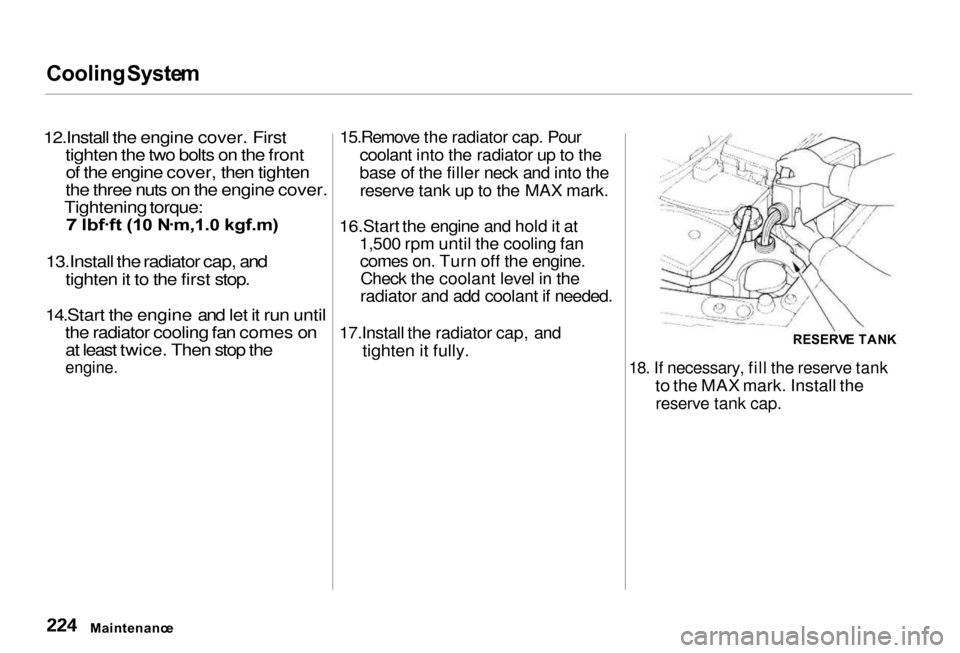
Cooling
Syste m
12.Install the engine cover. First tighten the two bolts on the frontof the engine cover, then tighten
the three nuts on the engine cover.
Tightening torque:
7 lbf .
ft (10 N .
m,1.0 kgf.m)
13.Install the radiator cap, and
tighten it to the first stop.
14.Start the engine and let it run until the radiator cooling fan comes onat least twice. Then stop the
engine.
15.Remove the radiator cap. Pour
coolant into the radiator up to the
base of the filler neck and into the
reserve tank up to the MAX mark.
16.Start the engine and hold it at 1,500 rpm until the cooling fancomes on. Turn off the engine.Check the coolant level in the
radiator and add coolant if needed.
17.Install the radiator cap, and tighten it fully.
18. If necessary, fill the reserve tank
to the MAX mark. Install the
reserve tank cap.
Maintenanc e
RESERV
E TAN K
Page 228 of 330
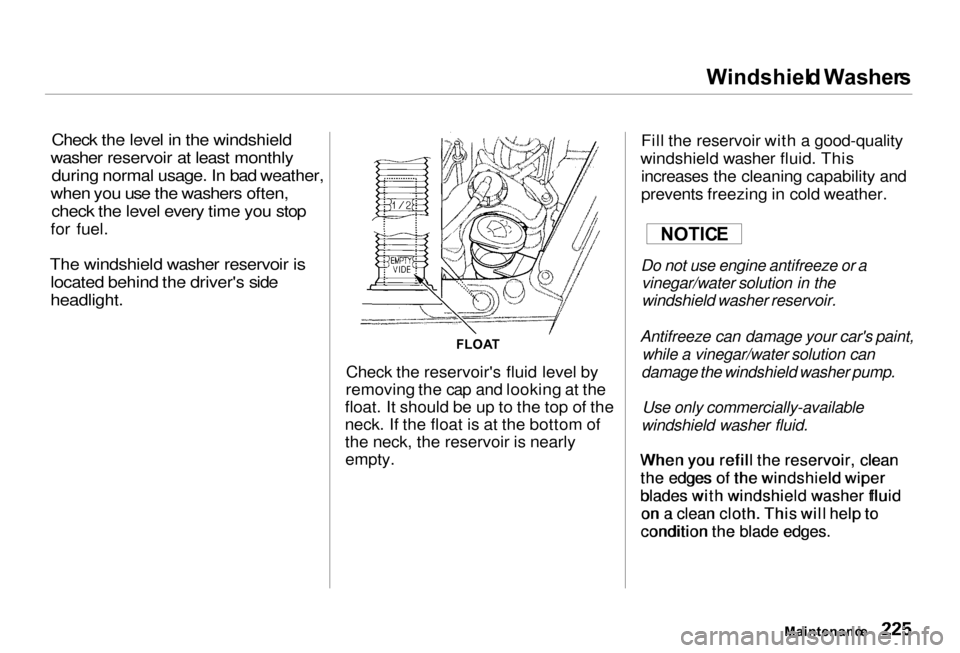
Windshiel
d Washer s
Check the level in the windshield
washer reservoir at least monthly during normal usage. In bad weather,
when you use the washers often, check the level every time you stop
for fuel.
The windshield washer reservoir is located behind the driver's side
headlight.
Check the reservoir's fluid level by
removing the cap and looking at the
float. It should be up to the top of the
neck. If the float is at the bottom of
the neck, the reservoir is nearly empty. Fill the reservoir with a good-quality
windshield washer fluid. This increases the cleaning capability and
prevents freezing in cold weather.
Do not use engine antifreeze or a
vinegar/water solution in the
windshield washer reservoir.
Antifreeze can damage your car's paint,
while a vinegar/water solution can
damage the windshield washer pump.
Use only commercially-available
windshield washer fluid.
When you refill the reservoir, clean the edges of the windshield wiper
blades with windshield washer fluid on a clean cloth. This will help to
condition the blade edges.
Maintenance
FLOA
T NOTIC
E
When you refill the reservoir, clean
the edges of the windshield wiper
blades with windshield washer fluid
on a clean cloth. This will help to
condition the blade edges.
Page 229 of 330
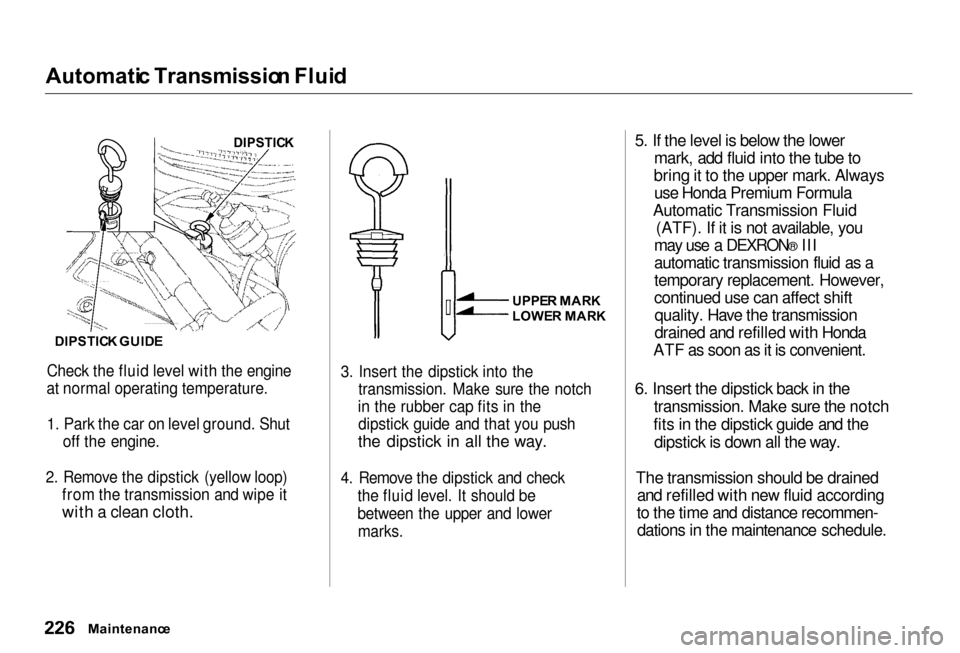
Automati
c Transmissio n Flui d
Check the fluid level with the engine
at normal operating temperature.
1. Park the car on level ground. Shut off the engine.
2. Remove the dipstick (yellow loop) from the transmission and wipe it
with a clean cloth.
3. Insert the dipstick into the transmission. Make sure the notch
in the rubber cap fits in the dipstick guide and that you push
the dipstick in all the way.
4. Remove the dipstick and check
the fluid level. It should be
between the upper and lowermarks.
5. If the level is below the lower
mark, add fluid into the tube to
bring it to the upper mark. Always use Honda Premium Formula
Automatic Transmission Fluid (ATF). If it is not available, you
may use a DEXRON® III
automatic transmission fluid as a
temporary replacement. However,
continued use can affect shift quality. Have the transmission
drained and refilled with Honda
ATF as soon as it is convenient.
6. Insert the dipstick back in the transmission. Make sure the notch
fits in the dipstick guide and the dipstick is down all the way.
The transmission should be drained and refilled with new fluid according
to the time and distance recommen- dations in the maintenance schedule.
Maintenanc e UPPE
R MAR K
LOWE R MAR K
DIPSTIC
K
DIPSTIC K GUID E
Page 231 of 330
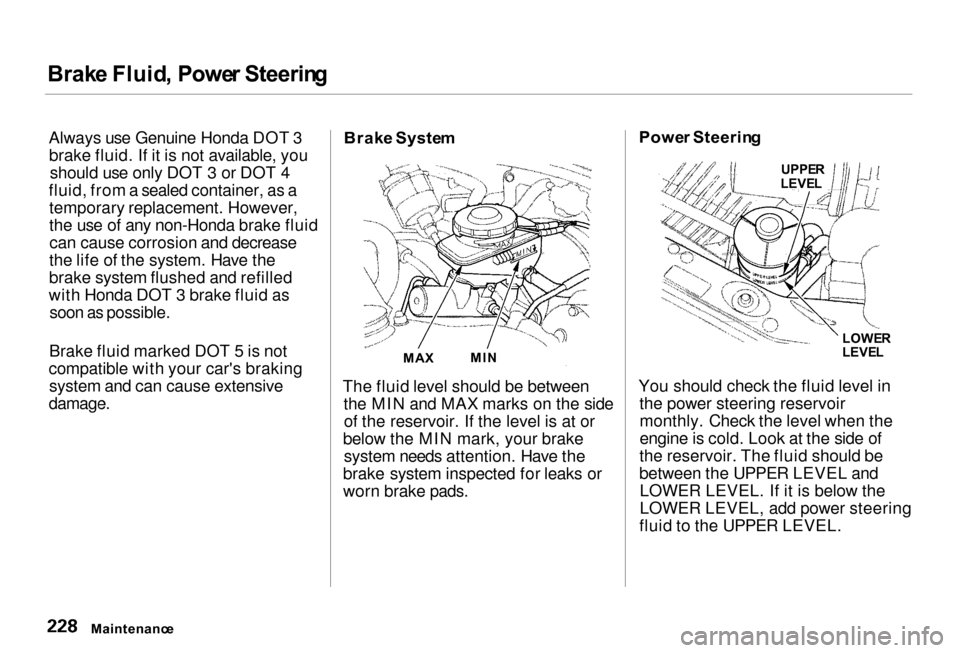
Brak
e Fluid , Powe r Steerin g
Always use Genuine Honda DOT 3 brake fluid. If it is not available, you should use only DOT 3 or DOT 4
fluid, from a sealed container, as a temporary replacement. However,
the use of any non-Honda brake fluidcan cause corrosion and decrease
the life of the system. Have the
brake system flushed and refilled
with Honda DOT 3 brake fluid as soon as possible.
Brake fluid marked DOT 5 is not
compatible with your car's braking system and can cause extensive
damage.
Brak
e Syste m
The fluid level should be between the MIN and MAX marks on the sideof the reservoir. If the level is at or
below the MIN mark, your brake system needs attention. Have the
brake system inspected for leaks or
worn brake pads. Powe
r Steerin g
You should check the fluid level in the power steering reservoirmonthly. Check the level when the
engine is cold. Look at the side of
the reservoir. The fluid should be
between the UPPER LEVEL and LOWER LEVEL. If it is below the
LOWER LEVEL, add power steering
fluid to the UPPER LEVEL.
Maintenanc e
MA
X MI
N LOWE
R
LEVE L
UPPE
R
LEVE L
Page 242 of 330
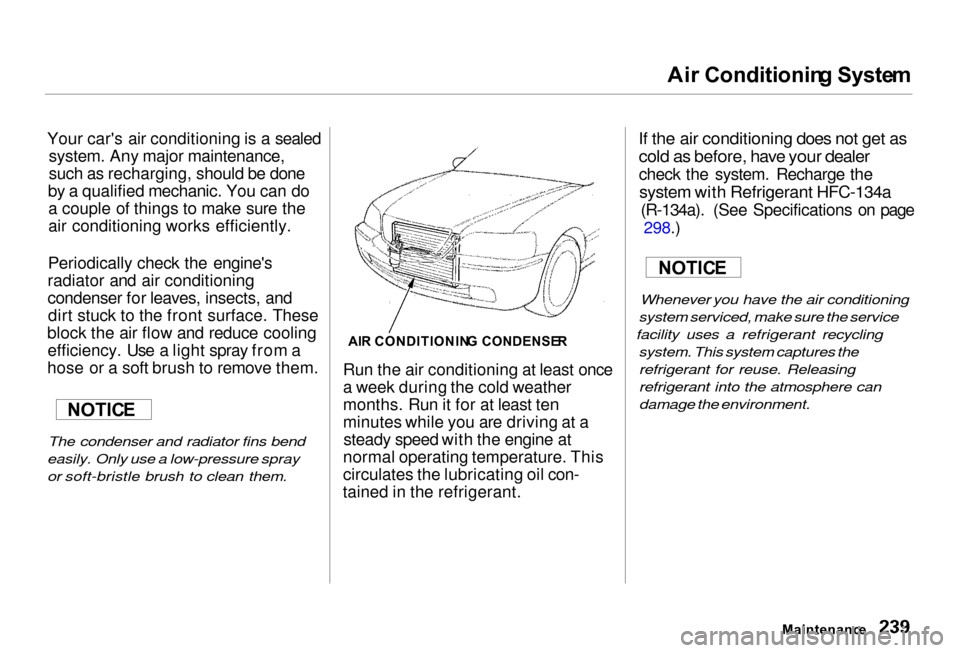
Ai
r Conditionin g Syste m
Your car's air conditioning is a sealed system. Any major maintenance,
such as recharging, should be done
by a qualified mechanic. You can do a couple of things to make sure the
air conditioning works efficiently.
Periodically check the engine's
radiator and air conditioning
condenser for leaves, insects, and dirt stuck to the front surface. These
block the air flow and reduce cooling efficiency. Use a light spray from a
hose or a soft brush to remove them.
The condenser and radiator fins bend
easily. Only use a low-pressure spray
or soft-bristle brush to clean them.
Run the air conditioning at least once
a week during the cold weather
months. Run it for at least ten
minutes while you are driving at a
steady speed with the engine at
normal operating temperature. This
circulates the lubricating oil con-
tained in the refrigerant.
If the air conditioning does not get as
cold as before, have your dealer
check the system. Recharge the
system with Refrigerant HFC-134a
(R-134a). (See Specifications on page 298.)
Whenever you have the air conditioning
system serviced, make sure the service
facility uses a refrigerant recycling
system. This system captures the
refrigerant for reuse. Releasing
refrigerant into the atmosphere can
damage the environment.
Maintenance
AI
R CONDITIONIN G CONDENSE R
NOTIC
E
NOTIC E
Page 272 of 330
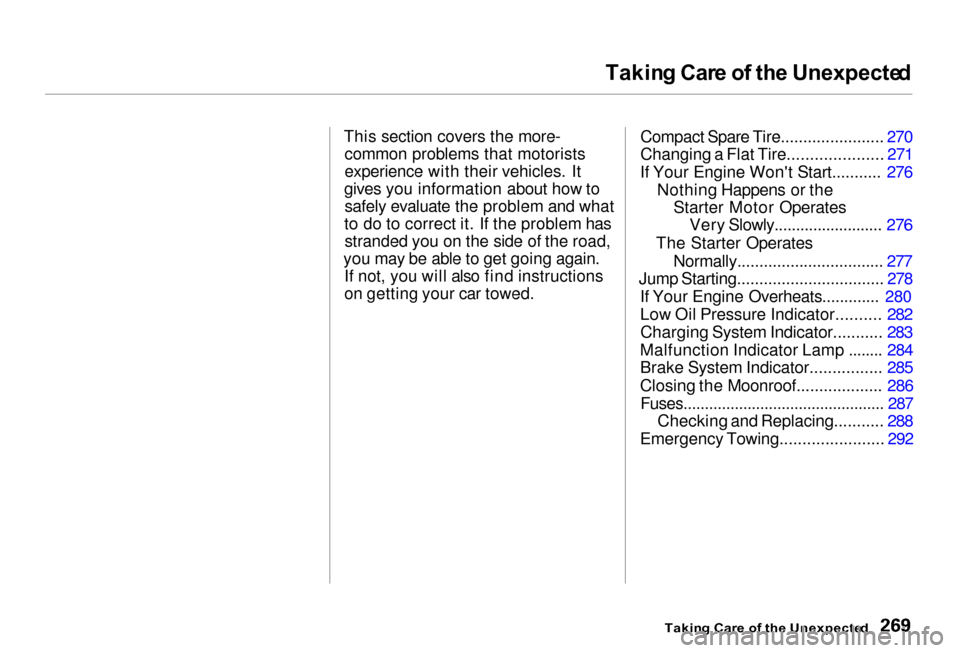
Takin
g Car e o f th e Unexpecte d
This section covers the more- common problems that motorists
experience with their vehicles. It
gives you information about how to safely evaluate the problem and what
to do to correct it. If the problem has stranded you on the side of the road,
you may be able to get going again. If not, you will also find instructions
on getting your car towed.
Compact Spare Tire....................... 270
Changing a Flat Tire..................... 271
If Your Engine Won't Start........... 276 Nothing Happens or theStarter Motor OperatesVery Slowly......................... 276
The Starter Operates Normally................................. 277
Jump Starting................................. 278
If Your Engine Overheats............. 280
Low Oil Pressure Indicator.......... 282
Charging System Indicator........... 283
Malfunction Indicator Lamp ........ 284
Brake System Indicator................ 285
Closing the Moonroof................... 286
Fuses............................................... 287
Checking and Replacing........... 288
Emergency Towing....................... 292
Takin g Car e o f th e Unexpecte d
Page 279 of 330
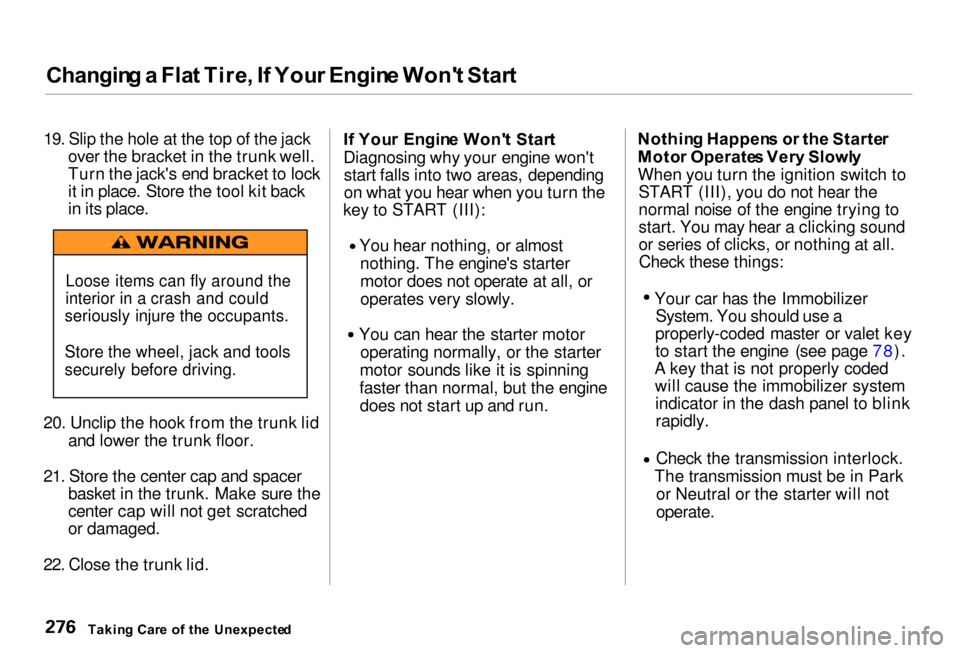
Changin
g a Fla t Tire , I f You r Engin e Won' t Star t
19. Slip the hole at the top of the jack over the bracket in the trunk well.
Turn the jack's end bracket to lock
it in place. Store the tool kit back
in its place.
20. Unclip the hook from the trunk lid and lower the trunk floor.
21. Store the center cap and spacer
basket i
n the trunk. Make sure the
center cap will
not get scratched
or damaged.
22. Close th
e trunk lid. I
f You r
Engin
e Won' t Star t
Diagnosing why your engine won't start falls into two areas, depending
on what you hear when you turn the
key to START (III): You hear nothing, or almost
nothing. The engine's starter
motor does not operate at all, or
operates very slowly. You can hear the starter motor
operating normally, or the starter
motor sounds like it is spinning
faster than normal, but the engine does not start up
and run. Nothin
g Happen s
o
r th e Starte r
Moto r Operate s Ver y Slowl y
When you turn the ignition switch to START (III), you do not hear the
normal noise of the engine trying to
start. You may hear a clicking sound
or series of clicks, or nothing at all.Check these things:
Your car has the ImmobilizerSystem. You should use a
properly-coded master or valet key
to start the engine (see page 78).
A key that is not properly coded will cause the immobilizer systemindicator in the dash panel to blinkrapidly. Check the transmission interlock.
The transmission must be in Park or Neutral or the starter will not
operate.
Takin g Car e o f th e Unexpecte d
Loose items can fly around the
interior in a crash and could
seriously injure the occupants.
Store the wheel, jack and tools
securely before driving.
Page 280 of 330
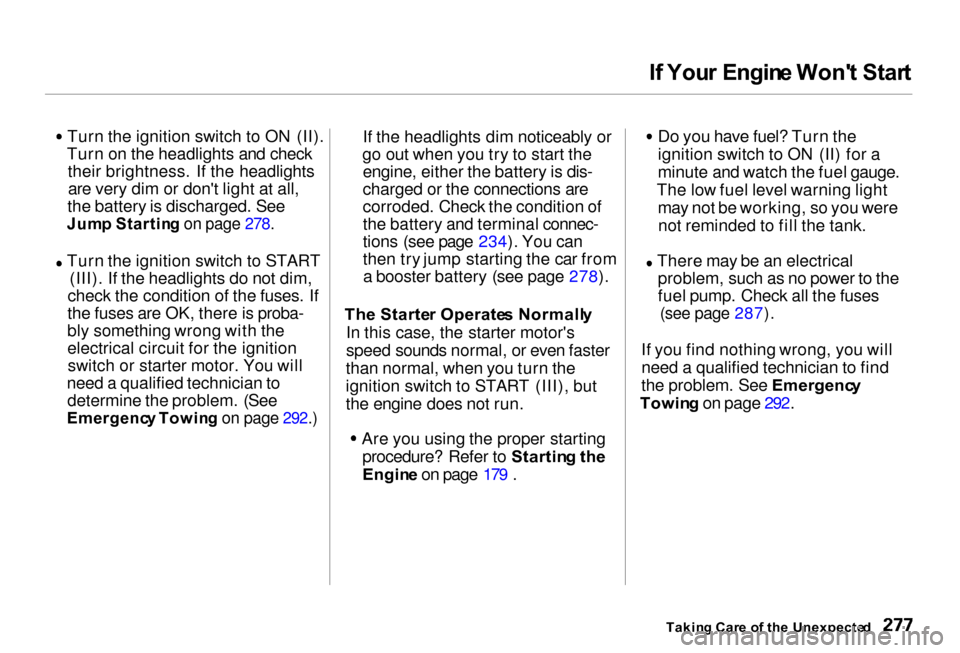
I
f You r Engin e Won' t Star t
Turn the ignition switch to ON (II).
Turn on the headlights and check their brightness. If the headlightsare very dim or don't light at all,
the battery is discharged. See
Jum p Startin g on page 278.
Turn the ignition switch to START
(III). If the headlights do not dim,
check the condition of the fuses. If
the fuses are OK, there is proba-
bly something wrong with the
electrical circuit for the ignition switch or starter motor. You will
need a qualified technician to determine the problem. (See
Emergenc y Towin g on page 292.)
If the headlights dim noticeably or
go out when you try to start the engine, either the battery is dis-
charged or the connections are
corroded. Check the condition of
the battery and terminal connec-
tions (see page 234). You can
then try jump starting the car froma booster battery (see page 278 ).
Th e Starte r
Operate
s Normall y
In this case, the starter motor's
speed sounds normal, or even faster
than normal, when you turn the
ignition switch to START (III), but
the engine does not run. Are you using the proper starting
procedure? Refer to Startin g th e
Engin e on page 179 . Do you have fuel? Turn the
ignition switch to ON (II) for a
minute and watch the fuel gauge.
The low fuel level warning light may not be working, so you werenot reminded to fill the tank. There may be an electrical
problem, such as no power to the
fuel pump. Check all the fuses
(see page 287).
If you find nothing wrong, you will need a qualified technician to find
the problem. See Emergenc y
Towin g on page 292.
Takin g Car e o f th e Unexpecte d
Page 281 of 330
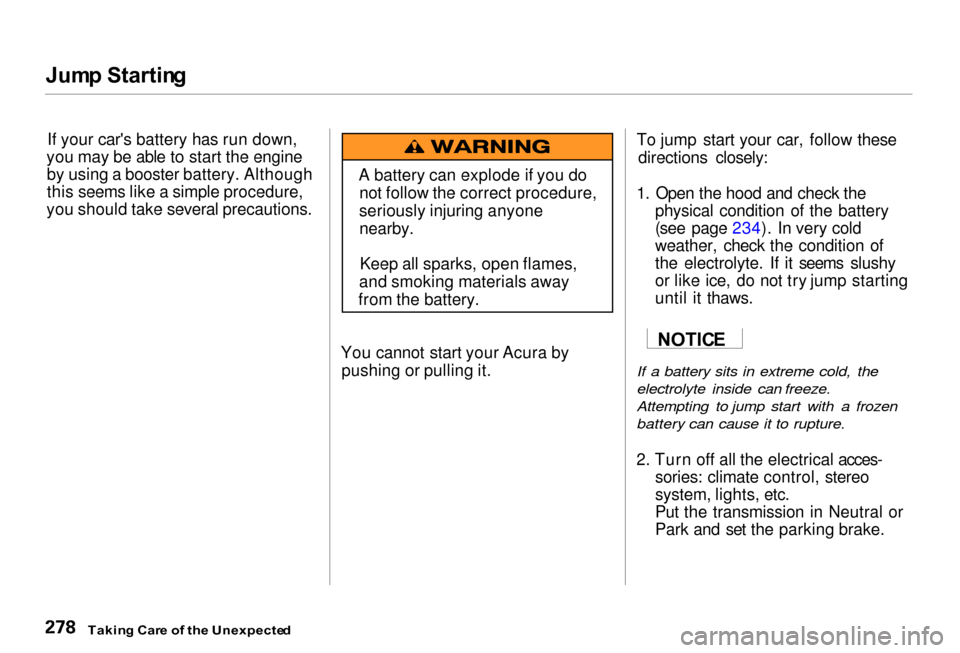
Jum
p Startin g
If your car's battery has run down,
you may be able to start the engine by using a booster battery. Although
this seems like a simple procedure,
you should take several precautions.
You cannot start your Acura bypushing or pulling it. To jump start your car, follow these
directions closely:
1. Open the hood and check the physical condition of the battery
(see page 234). In very cold
weather, check the condition of
the electrolyte. If it seems slushy
or like ice, do not try jump starting
until it thaws.
If a battery sits in extreme cold, the
electrolyte inside can freeze.
Attempting to jump start with a frozen
battery can cause it to rupture.
2. Turn off all the electrical acces- sories: climate control, stereo
system, lights, etc.
Put the transmission in Neutral or
Park and set the parking brake.
Takin g Car e
o
f th e Unexpecte d
A battery can explode if you do
not follow the correct procedure,
seriously injuring anyone nearby.
Keep all sparks, open flames,
and smoking materials away
from the battery.
NOTICE
Page 282 of 330
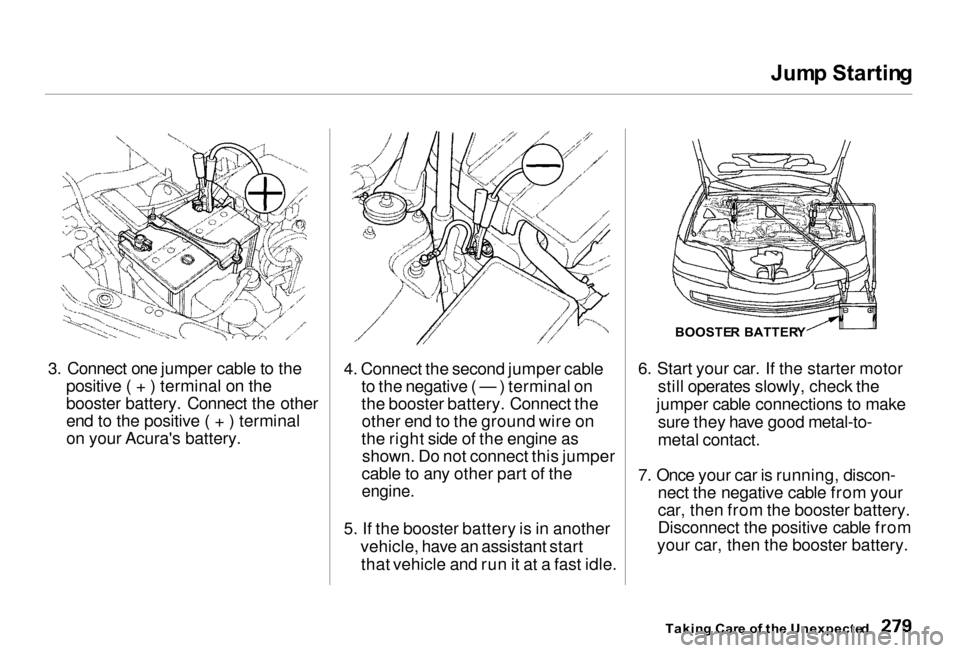
Jum
p Startin g
3. Connect one jumper cable to the
positive ( + )
terminal on the
booster battery. Connect the other
end to the positive ( + ) terminal
on your Acura's battery. 4. Connect the second jumper cable
to the negative ( — ) terminal on
the booster battery. Connect theother end to the ground wire on
the right side of the engine as shown. Do not connect this jumper
cable to any other part of the
engine.
5. If the booster battery is in another vehicle, have an assistant startthat vehicle and run it at a fast idle. 6. Start your car. If the starter motor
still operates slowly, check the
jumper cable connections to make sure they have good metal-to-
metal contact.
7. Once your car is
running, discon-
nect th
e negative cable from your
car, then from the booster battery.
Disconnect the positive cable from
your car, then the booster battery.
Takin g Car e o f th e Unexpecte d
BOOSTE
R BATTER Y